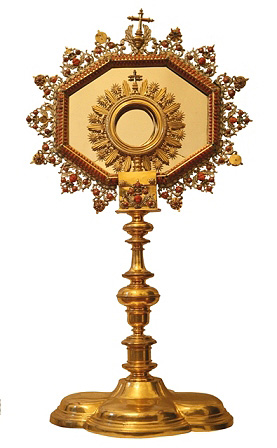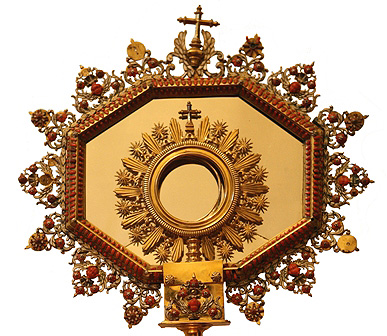Piece of the month of February 2011
framework O SICILIAN CORAL CORNICE IN VIDAURRETA
Ignacio Miguéliz Valcarlos
Chair of Navarrese Heritage and Art
The presence in Navarrese churches of works of silverware from foreign centres has been a constant feature throughout history, constituting one of the richest chapters in the study of Navarrese silverware. Among the pieces treasured by Navarrese churches are several works of Sicilian origin, all of which are highly attractive thanks to the materials they are made of, gilded bronze and coral. The use of this organic subject , in its intense red variety, gives these pieces an exotic and surprising appearance, which is alien to what was done not only in Navarrese workshops, but also in Hispanic and American workshops, where only the use of enamels could give goldsmiths' works similar chromatic values. Thanks to employment coral was also used to obtain plastic values that were highly appreciated in the centuries of the Baroque, when the taste for luxury and sumptuousness was very well defined, in an art whose aim was to exalt the senses.
The work in coral for the creation of artistic pieces underwent a strong development throughout the 16th century in Italy, especially in Sicily. On this island we find the fishing and manufacture of this material in Trapani, where the largest production centre was located, and where it was also used by the silversmiths of Palermo for the manufacture of their pieces. The masters of Trapani specialised in the creation of various carved figures in coral, taking advantage of the natural forms of the coral trunks, as well as pieces of silverware with articulated decorations based on coral inlays. These works were usually made in gilded bronze, although they were also made in gilded silver, and production included both religious and civilian pieces. To make the pieces, these masters cut the pieces of coral with saws and cut them down to the desired shape, losing much of the raw subject in the process, polishing the pieces before final assembly. Throughout the 17th century, the decorative motifs were articulated on the basis of gadroons, commas, rectangles, trapezoids and flower petals. In the case of the figures, coral carving was favoured at the end of the 16th century with the introduction, it is believed by the Trapanese silversmith Antonio Ciminello, of work with the burin, which allowed aesthetic and technical solutions to be applied in the execution of small figures, thus obtaining greater detail in the execution of these images.
In relation to this, in the church of San Julián de Vidaurreta a framework or cornice of gilded bronze, coral and enamels (33 x x .5 cm) dating from the late sixteenth and early seventeenth centuries is preserved, which in the second quarter of the seventeenth century was adapted as an ostensory (74 x .5 / 40 x x / 4 / 2.5 cm), adding a foot and a gilded bronze shaft of great simplicity. It is a framework of octagonal format, with the transverse axis of greater length and convex edge. This one presents the profile crossed by a cresting of a cresting of vegetal crests topped by oval mirrors with applications of rosettes, which alternate with others formed by plant elements on which are arranged cherubs with spread wings topped by three rosettes of coral. Field occupied by a sheet of mirror, which in the center has a monstrance with a circular virile molded, framed by a burst of alternating beveled rays with tornapuntas in ce ending in stars, all topped by a cross of rhomboidal arms ending in balls. On the back of the framework there is a gilded bronze plate with burin branch decoration articulated by means of flat ribbons and crosses that intertwine and intertwine, forming a central lacing pattern framed by crosses parallel to the edge.

Anonymous. First half of the 17th century and second quarter of the 18th century. Monstrance - framework. Vidaurreta. Church of San Julián
This work contrasts the simplicity of the foot and shaft, which are undecorated and base their richness on the architectural structure of their forms, with greater plasticity in the lobed and convex elements of the base, with the chromatic richness of the framework adapted as a monstrance. The surface of the latter is covered with deep red coral inlays, which are complemented by a beautiful polychromy based on white and, to a lesser extent, blue. Thus, on the edge of the framework , three bands of convex gadroons and buttons, of great simplicity, are arranged in a constant arrangement, in an orderly and rhythmic manner, following the fronts of the framework. Parallel to the edge of the framework is a straight band with a raised border decorated with a v-shaped motifs that converge in the centre, in which the ultramarine blue enamel alternates with white. This border is similar to the one that appears in the same arrangement on a header image with the Immaculate Conception from the National Archaeological Museum in Madrid and another from a private collection in Barcelona. The cresting that outlines this framework is made up of openwork plates cut in the form of triangular profile . Two different motifs are arranged alternately, very similar in their arrangement and enamelling to those that make up the cresting on the cresting of the two header images with the Annunciation in the Whitaker collection and in the Museo Nacional de Artes Decorativas in Madrid, both from the first half of the 17th century, and that of an aquabenditera in the Museo Liverino in Torre del Greco, as well as the ends of the arms of an altar cross from the collegiate church of Santa Maria Della Pieve di San Ginesio in Macerata. A similar framework to the one studied here, called Cornice in Italy, can be found in the Museo Nazionale Duca di Martina in Naples, with slight variations in the articulation of its sides and the cresting that surrounds it. The richness of this piece is also marked by the work that the framework offers us on the reverse, with a beautiful ornamentation based on geometric elements and flat interlaced ribbons, very carefully and finely executed, in which the striped surface of the decorative motifs contrasts with the plain background. This decoration on the reverse is a testament to the quality of the piece. As it was placed on a wall, this part was not visible and therefore its decoration went unnoticed, despite which it received an exquisite decorative treatment.
Due to the loss of the Vidaurreta parish books, the arrival of this piece in the church is an unknown quantity, as we do not know the identity of the silversmith who made the adaptation of the framework as an ostensory, nor the exact date of its execution, and we also do not know when it was donated to the church. Likewise, we do not know the name of the person who bequeathed this sumptuous work to the church of Vidaurreta, although given the magnificence of the gift we are dealing with a person in a privileged economic position partner , and who, due to the origin of the piece, lived for some time in Sicily. This work should probably be linked to the lords of the Vidaurreta palace, one of those recognised as an armoury corporal, in the possession of the González de Vidaurreta family. The work would probably have been given to the parish church when it was renovated to convert it into a monstrance, therefore in the second quarter of the 18th century, when in 1728 María Teresa González de Vidaurreta, heiress to the entailed estate, married Juan Pérez de Rada y Echalaz, second Marquis of Zabalegui, and came to live in Muruzabal. This reliquary may be a donation to recall the lineage's links with the village that had given them their name.

Anonymous. First half of the 17th century and second quarter of the 18th century. Monstrance - framework (Detail). Vidaurreta. Church of San Julián
bibliography
J.M. Cruz Valdovinos, European Silverware in Spain. 1300-1750, Madrid, 1997.
C. del Mare, and Mª.C. di Natale, Mirabilia Coralii. Capolavori barocchi in coralli tra maestranze ebraiche e trapanesi, Naples, 2009.
M.C. Di Natale, "L'arte del corillo tra Trapani e la Spagna", in J. RIVAS CARMONA (Coord.), programs of study de Platería. San Eloy 2010, Murcia, 2010.
I. Miguéliz Valcarlos, "Orfebrería siciliana con coral en Navarra", in OADI. Rivista dell'Osservatorio per le Arti Decorative in Italia, Anno 2, nº 1, Palermo, 2011.
